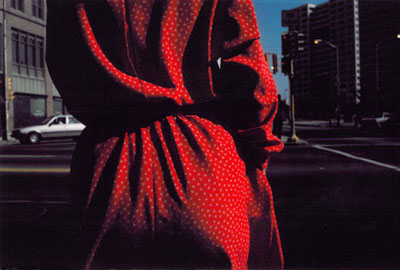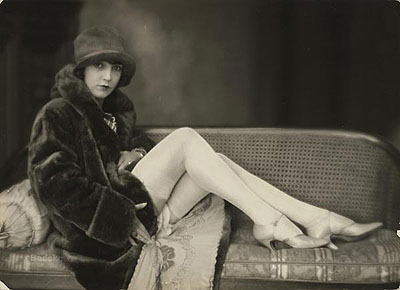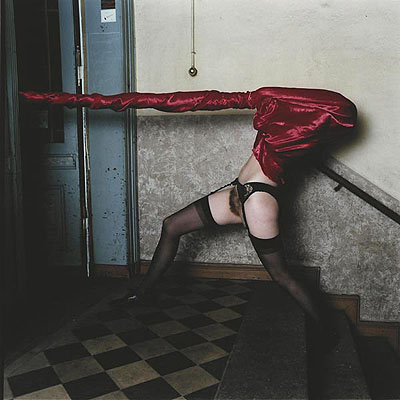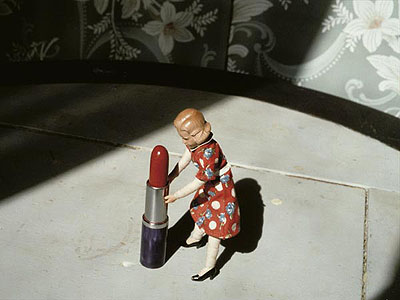
fashion room
Fotografien aus der Sammlung F.C. Gundlach
Martin Badekow » Anna & Bernhard Blume » Katharina Bosse » Harry Callahan » Ralph Gibson » F.C. Gundlach » Robert Heinecken » George Hoyningen-Huene » David LaChapelle » Saul Leiter » Zoe Leonard » Olaf Martens » Gjon Mili » Hans Pieler » Heinrich Riebesehl » Franz Roh » Laurie Simmons » Melvin Sokolsky » Imre von Santho » Wols (Alfred Otto Wolfgang Schulze) » & others
Exhibition: 10 Sep – 8 Nov 2009
Museum für Angewandte Kunst Frankfurt
Schaumainkai 17
60594 Frankfurt (Main)
Museum für Angewandte Kunst
Schaumainkai 17
60594 Frankfurt (Main)
069-21234037
Tue-Sun 10-17, Wed 10-21

FASHION ROOM: PHOTOGRAPHS FROM THE F.C. GUNDLACH COLLECTION. Every fashion needs its room. Clothing fashion is three-dimensional by definition: it envelops the body, it forms, exposes or conceals the body, brings out certain parts of the body and makes others disappear. Yet fashion is ephemeral, and needs photography to ensure its survival. In the process, fashion's spatial dynamic is transferred to the two-dimensional plane of the photographic exposure. The perception of the original fashion room changes, and new interpretation rooms are introduced. The real room - the street, the shop window or the catwalk – is joined by societal, culturally encoded rooms. The exhibition FASHION ROOM presents photographic strategies for the staging of clothing fashion in space, and conceives of the term "room" as the model of a conceptual space extending far beyond the space described by architecture. Every fashion photograph shows the era-specific perception of fashion, and with it the underlying relationships between fashion, culture and society. The selection FASHION ROOM from the F.C. Gundlach Collection, however, is not limited to fashion photography in the classical sense. A chief focus of the exhibition is the dialogical element of photography: the interaction between fashion, space and pictorial surface over the course of time and photographic history. An important selection criterion for the photos to be shown in this context was the principle of the series. Preference was given to examples which transport conceptual meaning in series. Motif series by such photographers as Martin Badekow, George Hoyningen-Huene, Imre von Santho, Franz Roh or Wols dating from the 1930s to the 1950s constitute the chronological beginning, and are followed by works of Ralph Gibson, Saul Leiter, Zoe Leonard, Gjon Mili and Melvin Sokolsky of the 1960s and 1970s. Works by Katharina Bosse, Robert Heinecken, Chris Moore and David LaChapelle round out the presentation. The photo series selected reveal the photographers' differing approaches. Melvin Sokolsky's well-known "Bubble Series", taken for Harper's Bazaar in Paris in 1963, is a particularly striking commentary on the photographic act of staging fashion in space. Sokolsky had his favourite model Simone d'Aillencourt pose at distinctive sites in Paris, thus placing the haute couture designs into a context with that city's flair. At the same time, however, in her Plexiglas sphere, the model remains visually and physically isolated; Paris becomes a stage set. This interplay between proximity and inaccessibility, between the two-dimensional and the three-dimensional, ultimately creates an awareness of the "re-presentative" function of the photograph and the distance between the subject and the viewer. In contrast, Gijon Mili's and Frank Horvat's photographs initially defy location in space. The figures are cut out; their surroundings remain unclear. Through the arrangement of the folds of the graphically expressive design, however, Mili and Horvat succeed in creating spatial structures within the textile that serve to convey an impression of the coats' volume and cut. This strategy of abstraction culminates in the series by James Welling, in which he stages pictorial spaces solely through the photographed folds of lengths of fabric. Saul Leiter works with the spatial effects of extreme perspectives on – and optical distortions of – the figure and garment. Even if he likewise makes use of cutting, the location of the shot can always be fundamentally recognized: a street and wall of posted bills stand for the urban metropolis, for example, the make-up mirror for the intimate interior. However similar their works are in other respects, contrary strategies for the treatment of space and perspective can be discerned in the fashion photos of Katharina Bosse and David LaChapelle. Whereas the locations of Katharina Bosse's shots remain general, the spatial situation confined, the figures pushed into a corner – also with regard to their poses -, the photos of LaChapelle place the fashion and the models into the context of clearly recognizable architectural structures. In the latter works, the generous openness of the gestures reinforces the expanse of the space and draws attention to the luxury and glamour of the clothing designs. The photos by Imre von Santho of the 1930s, characterized by their wealth of contrast, and George Hurrell's hand-coloured scenes of the 1940s can be understood as examples of colour and light rooms in the studio. Imre von Santho illuminated simple paper backdrops and geometric surfaces with studio spotlights, thus creating light spaces for his rigorous black-and-white fashion shots. The poses and gestures of the models take the light surfaces as their orientation; shadows and shades of grey provide spatial depth. George Hurrell, known for his portraits of Hollywood movie stars, likewise remained in the studio for his fashion photos. There he made use of projection and multiple exposures and contrasted the chromatically subdued clothing designs with handcoloured chromatic spaces. In keeping with the creed of the F.C. Gundlach Collection, the exhibition also encompasses conceptual and artistic approaches in which clothing played a role. Harry Callahan's photographic depictions of shop windows, for example, react to the visual fascination of fashion and mannequins behind glass which, although they are corporeal in quality, cannot be encircled, much less physically touched, due to their placement behind the pane of glass. Reflections in the glass moreover obscure the spatial situation and create a mysterious atmosphere in which reality and fiction merge. This theme is enhanced by shop-window shots of various other photographers, some viewing the shop-window decoration from the outside, others the window-shopper from within. Heinrich Riebesehl's series of People in Lifts is rooted in the tradition of Henri Cartier-Bresson's or Helen Levitt's subway scenes. Since the photos were taken with a hidden camera, the subjects were unaware of being observed in the confined, intimate space of the lift interior, and thus present clothing in everyday life in an apparently completely natural manner. Forty years later, these photographs transport the tastes of the respective era all the more distinctly and – due particularly to their conceptual rigour – have become documents of everyday design. The series Neufünfland by Hans Pieler, as well as Bernhard and Anna Blume's fourpart Wahnzimmer develop the show's argumentation further. Finally, FASHION ROOM presents the diametric opposite to classical fashion photography with the series by Ruth Hallensleben and Grant Mudford, which are primarily concerned with the reciprocity of fashion, design and architecture. The F.C. Gundlach Collection In their selection of photographs for the exhibition FASHION ROOM, the curators had a myriad possibilities for the staging of fashion and patterns for its perception at their disposal in the extensive holdings of the F.C. Gundlach Collection. F.C. Gundlach (b. 1926), himself one of the most prominent fashion photographers in the Federal Republic of Germany, built up his collection "Zum Bild des Menschen in der Photographie" ("On the Image of the Human Being in Photography") over several decades, developing it into one of the most important private photo collections in existence. This collection's core holdings found a new home when the Haus der Photographie, founded by F.C. Gundlach, opened in the southern Deichtorhalle in Hamburg. In 2006, with the exhibition "The Heartbeat of Fashion", F.C. Gundlach presented the first comprehensive exhibition on fashion photography from his collection. The F.C. Gundlach Foundation To guarantee the safekeeping of his lifework and his photography collection on a long-term basis and provide the conditions for the active, scholarly and creative handling of his entire photographic holdings, F.C. Gundlach founded the F.C. Gundlach Foundation in 2002. The foundation's purpose is the fostering of art, scholarship and research in the area of photography, and in particular of photography as a cultural asset. The curators of the exhibition FASHION ROOM have been research associates with the F.C. Gundlach Foundation for many years. Among the other exhibitions they have curated is "F.C. Gundlach. Das fotografische Werk" ("F.C. Gundlach: The Photographic Oeuvre"; in collaboration with Klaus Honnef and Hans-Michael Koetzle)for the Haus der Photographie Hamburg (2008), to be opened at the Martin Gropius Building in Berlin in November 2009.

